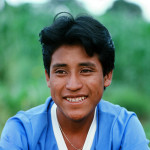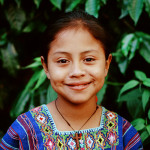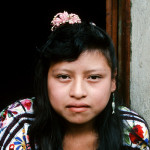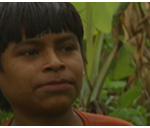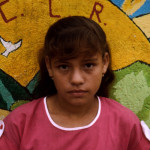Please note that all the information about a character is on just one page, so the only links in this Content Overview are the character’s names, which will take you to his or her page if clicked. Once you’ve watched a given character’s introductory video, click on a tab heading to select the ancillary material you want to explore and scroll down to view it.
In DIEGO’S STORY, Diego explains that his father had been a community leader. During the war, he and a dozen other men were killed and their bodies dumped in a ravine. Young Diego and his family watch the exhumation of their remains. Finally, they can give his father a dignified burial. Years later, the adult Diego visits family graves on Day of the Dead. He insists that he feels no vengeance and that the community needed to pull together to make a new start.
“Who Killed Diego’s Father?” looks at the role of the civil patrols in the counterinsurgency war, explaining its roots dating back to the 1954 CIA coup; how the civil patrol functioned to keep control of the rural male population and its impact on communities; and presents findings of the Truth Commission.
“Who Is Digging?” examines the role of forensic anthropologists in the aftermath of the war and the importance of their work in bringing those responsible for the atrocities to justice.
“Diego’s Maya Heritage” briefly talks about the ancient Maya civilization before exploring the complexities of defining who is Maya in today’s Guatemala.
“Watch More of Diego” includes short videos of Diego giving his assessment of the war; recalling the difficult time following the death of his first wife; and showing his family celebrating Day of the Dead.
In DORA’S STORY, Dora explains that her family is displaced. She talks about her disappeared uncles, who were the kind of people targeted during the violence, and how civilians and especially the Maya suffered the most. Dora explores Maya identity issues both as a child and adult, commenting on the use of her Maya clothing and discrimination. She shares her love of teaching as well as her happiness that now she can return to her home village, which was too dangerous when she was a child.
“Why Were Civilians Hit the Hardest?” explains the devastating impact of the army’s counter-insurgency campaign on the civilian population.
“What Does It Mean To Be Displaced?” places Dora’s family in the context of other displaced people during the war, explores how it affected her life in some unexpected ways, and talks about her future goals.
“What Is A Disappeared Person?” explains how this weapon of terror was used and against whom. It looks at the response of family members who formed human rights organizations to seek both the truth about what happened to their loved ones as well as justice for those responsible.
“Watch More of Dora” includes short videos of Dora and her mother visiting her grandmother’s grave; Dora commenting on the massacres and genocide; sharing her gratitude toward her parents for her education; talking about her future ambitions; and explaining the cause of violence in Guatemala today.
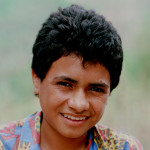 JUAN
JUAN
JUAN’S STORY tells how Juan grew up in an orphanage in San Salvador following the death of both of his parents in the war. He recounts the enormous difficulties he faced trying to continue his education while supporting himself as a young adult. Eventually he decided to emigrate to the United States, where he met his wife, opened a landscaping business and became a father.
“Who Killed Juan’s Parents? recounts the story of what happened to Juan’s parents and how the children were brought to an orphanage by two of the four US nuns who were later murdered, causing a ripple in US policy toward El Salvador. The orphanage was named for Archbishop Óscar Arnulfo Romero, whose assassination sparked a turning point in the war. Pope Francis beatified Romero in 2015, sparking massive celebrations in the streets of San Salvador.
“The War’s Aftermath” explains that the war ended in 1992 with the UN sponsored Peace Accords. The FMLN became a political party and has alternated power with the right-wing ARENA party ever since. An amnesty law passed to protect war criminals right after the war was struck down in 2016. Today, it is the extraordinarily high levels of violence that characterize life in El Salvador, impacting youth the most. Although most young people reject violence, emigration is seen by many as the only solution.
“Immigration Myths and Facts” counters six common misperceptions about immigration with facts: 1. Unauthorized immigrants take jobs from US workers. 2. Unauthorized immigrants don’t pay taxes but get benefits. 3. The US is overrun with immigrants, most of whom are unauthorized. 4. People wishing to enter the US should just go get in line. 5. Unauthorized immigrants boost the crime rate. 6. Unauthorized immigrants pose a security threat.
“Young Immigrants in the United States” focuses on the experience of unauthorized young people in the US, whose status makes it difficult for them to lead full lives. It highlights the “undocumented and unafraid” movement demanding that undocumented youth be given equal access to higher education and a path to citizenship. President Obama’s executive order known as DACA (Deferred Action for Childhood Arrivals) has provided relief for some, but many are not eligible, including the approximately 115,000 Central American unaccompanied minors who entered the US in recent years. While they face numerous challenges in the US, their larger fear is being sent back to the violence that they fled from.
“A Humanitarian Immigration Policy” suggests that there is a consensus that immigration reform is necessary, but disagreement on the specifics, due in large part to the controversy over the 11.2 million unauthorized immigrants. A humanitarian immigration policy would embody some version of the following goals: promote family reunification; create a path to citizenship; end mass detentions; demilitarize the border region and protect the rights of border communities; and focus enforcement efforts on genuine threats. With no Congressional action, Obama issued executive orders: DACA, giving some relief to young unauthorized immigrants and DAPA, which was halted in court. More people have been deported during the Obama administration than under any other president in history.
ROSARIO’S STORY recounts what happened the night of a massacre in Santiago Atitlán when her brother – and 12 others – were killed by the armed forces occupying the town. The adult Rosario talks about a new wave of violence and how it affects their family’s precarious financial situation. Nonetheless, Rosario lives happily with her husband and children.
“Before & After the Massacre” digs deeper into the context for the massacre, which came after a decade of army abuses in Santiago Atitlán. Archival video clips show the local, national and international response to the massacre, which resulted in the army being forced out of the town. A short clip shows Rosario and her family celebrating mass on the anniversary of the massacre at the site where the townspeople died.
“The Legacy of Violence” probes the impact of decades of political violence on the Guatemalan people and society. It discusses the current criminal violence haunting Guatemala, including gangs and drug trafficking. It highlights the role of a United Nations backed independent judicial watchdog organization in going after clandestine criminal networks, many of which came into being after the war as the army turned to organized crime and corruption instead of warfare. Revelations in the spring of 2105 about an extensive customs tax fraud scheme inspired massive protests which ultimately led to the resignation of the President and many other government officials.
“What Language is Rosario Speaking?” looks at the Mayan languages historically and more recently as the society tries to come to terms with being a multilingual nation. The role of bilingual education is explored. There is mention of the important step of determining a single convention for writing the Mayan languages in promoting literacy.
“Maya Clothing” explores the meaning and importance of traditional clothing – called traje – for the Maya, especially the women. It looks at the huipil, or blouse, as one of the most striking representations of Maya culture. It explores how women have been forced to change their clothing due to discrimination, repression and/or economics and what that means in terms of their identity. The text also brings in commentary suggesting that the decision to wear traje can be a political act, challenging those who have ruled over and discriminated against the Maya for centuries.
“Growing Up in Guatemala” highlights how difficult it is for most young people in Guatemala to obtain an education, which thus affects their opportunities for employment. Few young people have confidence in their democracy. Recent revelations of rampant governmental corruption sparked widespread and ongoing demonstrations, and young people, using social media, have been key in organizing them.
In SEBASTIAN’S STORY he explains how he and others fled the army violence. We see the very rudimentary school and difficult living conditions of his community hidden in the mountains. The adult Sebastián tells of surviving a massacre where his mother and other relatives were killed. He talks about the difficulties of supporting his family and his hope that his children can receive the education he never got.
“Resisting the Army Repression” explores the scorched earth policy of the army toward the Ixil people, which resulted in massacres and massive displacement of the population. It explains the formation of the Communities of Population in Resistance (CPR), which is where Sebastián was living when filmed as a child, and explains how they made themselves known to the world and then were finally disbanded after the Peace Accords were signed in 1996.
“Was Anyone Punished for the Massacre?” examines the trial of former dictator Gen. Efraín Ríos Montt who was charged with genocide in 2013. It outlines the charges against him, and summarizes the testimonies of the Ixil survivors and several expert witnesses. Although Ríos Montt was found guilty, the verdict was overturned shortly thereafter. Yet the importance of the evidence remains as an acknowledgment of the systematic destruction of Maya communities.
“Conflicts in the Ixil Region Today” looks at several examples of the controversy around mining and hydroelectric projects. It explains the concept of “free, prior and informed consent,” which is not being honored with these projects. It presents the view of Ixil leaders questioning just who is benefitting from the projects.
“Struggling to Provide for Your Family” digs deeper into what it really means to be poor in rural Guatemala, in terms of housing, health, water, education, food and trying to earn an income.
In YESENIA’S STORY, she recounts her fears during the war; her fervent desire to continue studying; coming to San Salvador and ending up a single mother after her husband left for the US; and how she derived strength from surviving the war which she draws on to confront other life challenges.
“Why Do the Planes Say ‘USA’ on Them?” discusses the US financing of the Salvadoran war; the cycle of repression and rebellion and formation of the FMLN rebels; and findings of the Truth Commission report about atrocities and responsibility.
“What Is Solidarity?” looks at the solidarity movement that opposed US intervention in Central America and focuses on the sister city relationship between San José Las Flores (Yesenia’s hometown) and Cambridge, Massachusetts.
“Why So Many Separated Families?” talks about root causes of the recent influx of Central American children to the US, including war, poverty, gang and drug violence, and the impact of trade and other policies.
“Since I Survived the War…” explores the concept of “psychosocial” trauma experienced by survivors of the war, as developed by Ignacio Martín-Baró, one of the Jesuits murdered in El Salvador in 1989. We present two examples of community based projects that are putting Martín-Baró’s philosophy into practice.
“Watch More of Yesenia” includes one video of her as a child visiting her father in a FMLN camp and another talking about what she wants for her birthday. As an adult, she talks about why she feels the war was just; questions the role of US foreign policy; gives her definition of solidarity; and explains how the teachers at her school share their salaries to pay hers.


